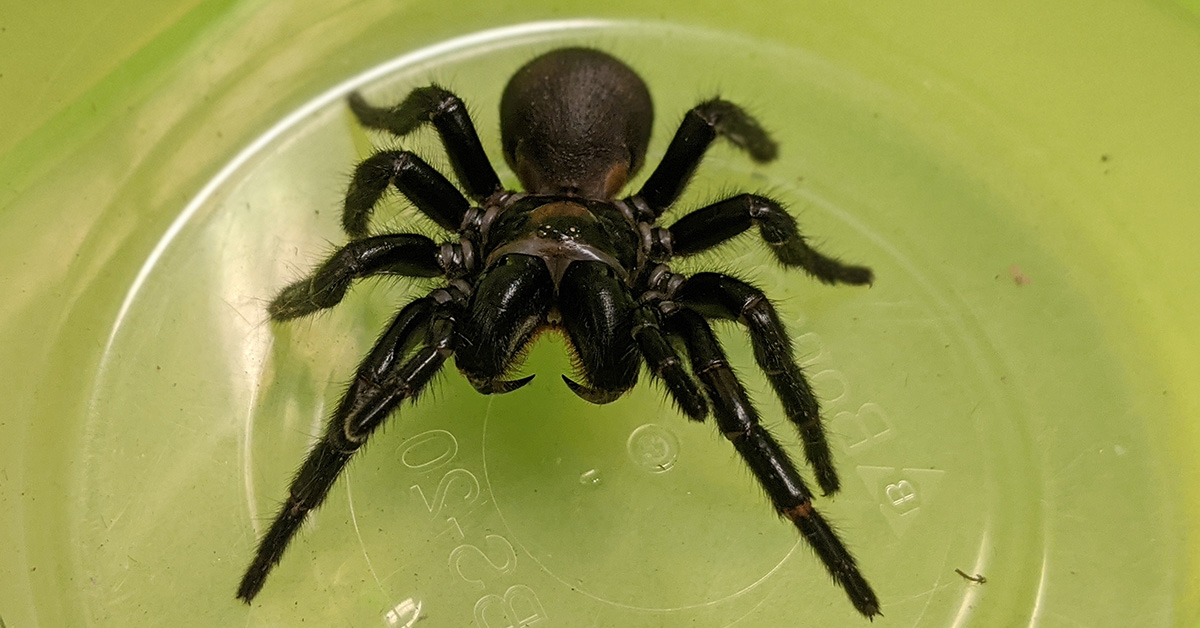Known by the First Peoples of K’gari (Fraser Island) as the ‘long-toothed spider’, the K'gari (Fraser Island) funnel-web may hold the key to some astounding medical breakthroughs.
Funnel-web spiders are legendary. With a big black body and large fangs, they have a well-deserved, fierce reputation as Australia’s deadliest spiders. There are more than 40 species in Australia, and they are found in all sorts of places, including on the gorgeous Queensland paradise of K’gari (Fraser Island).
The funnel-web that lives there is very special. Having been isolated on Fraser for about 20,000 years, it has developed different venom to other funnel-webs. Its venom – one of the most lethal spider venoms in the world – has been recorded as six times more powerful than that of the deadly Sydney funnel-web spider.
Yet this island population of spiders wasn’t even known to modern science until 1995, when someone was bitten by one. (Yes, the person survived, as has everyone bitten by a funnel-web since the antivenom was invented in 1981). Some experts say there are another 300 spider species on Fraser Island just waiting to be discovered.
Its venom is also one of the most complex in the world, with some 3000 peptide molecules. Of these, only a handful are lethal – the other 2990 or so may well have medical or other uses.
What’s special about this spider?
The Fraser Island funnel-web is currently considered the same species (Hadronyche infensa) as the so-called Toowoomba funnel-web, which is found north of the Hunter River in New South Wales into south-east Queensland. However, due to millennia of isolation, the Fraser Island funnel-web is genetically different. It can be found living in leaf litter in rainforest areas, but the most studied population lives in heathy sand hills around Orchid Beach in the island’s north. It’s unusual for funnel-webs to live in sand, and this choice of home has helped researchers studying them, because it’s easier to extract them from sandy surroundings compared to other habitats.
K’gari’s First Nations Butchulla people call the spider mudjar nhiling guran, which means long-toothed spider. Like most funnel-webs it has a pair of very large, intimidating fangs, spaced about one centimetre apart.
What does the Fraser Island funnel-web look like?
With a black or dark brown body covered by a glossy carapace at the front, the funnel-web measures some 5–10 centimetres from leg tip to leg tip, with a body 1–5 centimetres long. IMB’s Dr Natalie Saez, who milks their venom to identify the peptides, said, “They’re not too hairy – well, not in terms of the tarantulas I’m used to looking at.”

What does this spider’s burrow look like?
Funnel-web burrows are nearly always on the ground – under logs or rocks – but occasionally can be found in trees. They have long silk threads funnelling in towards a small hole. The burrow itself is also lined with silk, and the spider usually resides in a short tunnel (less than 30 centimetres long), waiting for a beetle, cockroach or small skink to trigger one of the threads. Then it pounces, injecting the lethal venom.
Is it likely you’ll get bitten?
No. Although the human residents of Orchid Beach are very aware of the funnel-webs living in the area, they rarely see them. As humans are certainly not a food source, the funnel-webs would only strike if they felt threatened. “They do have a bit of a reputation for being aggressive, but they’re more defensive than anything,” Dr Saez said. “Unless you’re literally sticking your finger in the hole, or otherwise provoking them, you’re not going to have a problem.”
Generally, the spiders will keep to themselves. During the warmer seasons of summer and autumn, males searching for a mate can be found wandering around. Before the spider is going to strike, it will stand on its back legs to make itself look bigger. “Making venom uses a lot of energy, so if the spider can avoid using it, they will.”
In the unlikely event someone is bitten, symptoms may include severe local pain, superficial inflammation of the skin, sweating and nausea. The large fangs will leave distinct puncture wounds up to one centimetre apart.
Treatment for funnel-web bite is the same as for a snake bite – apply a compression bandage and keep the limb and person still until help arrives. “Stay calm, apply a compression bandage and call triple zero, and try not to move around much,” Dr Saez said.
What do we know about the venom?
The toxicity of the venom can vary, depending on the age and sex of the spider. Researchers studying the peptides in the venom have discovered a special molecule with great potential for beneficial uses – from treatment of stroke and heart attack, to prolonging the storage time of donor hearts for transplant. Other peptides may be useful as insecticides – venom from another type of funnel-web has been used to manufacture insecticides available in the USA.

